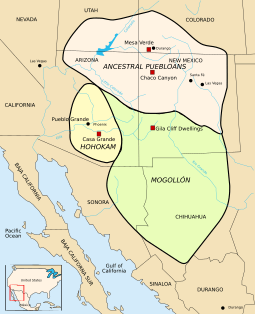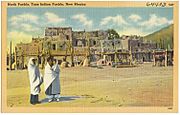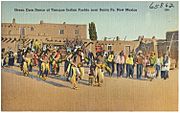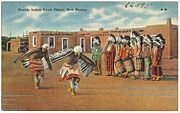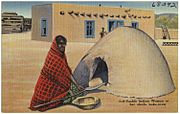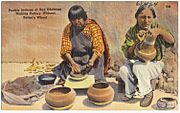Pueblo V Period facts for kids
The Pueblo V Period (from about 1600 AD to today) is the most recent time period for the Ancestral Puebloans. These were ancient people who lived in the Southwestern United States. This period also includes the Pueblo peoples who live there now.
During the previous Pueblo IV Period, there were 19 pueblos (villages) in the Rio Grande valley. All of these are still active today. In Texas, only Ysleta del Sur Pueblo remains. In Arizona, only the Hopi Tribe pueblos are still active. Most other pueblos from the Pueblo IV Period were left empty by the 1800s.
The Pueblo V Period is also sometimes called the "Regressive Pueblo Period."
Contents
History of the Pueblo V Period
Many big changes happened during the Pueblo V Period. This was because of the Spanish colonization of the Americas starting in the 1500s. Later, the United States expanded westward in the 1800s and 1900s.
These changes led to several things:
- The number of Pueblo people went down. This was mainly because of new sicknesses brought by Europeans.
- Europeans and other Native American tribes tried to take over traditional Pueblo lands.
- Indian reservations were created. These were special areas of land set aside for Native American tribes.
The Crow Canyon Archaeological Center says that "Today, Pueblo people live in the modern world while keeping their unique culture and rich traditions."
Ancient Cultural Groups
During this time, several important cultural groups lived in the Southwest. They included:
- Ancestral Puebloans – They lived in southern Utah, southern Colorado, northern Arizona, and northern and central New Mexico.
- Hohokam – These people lived in southern Arizona.
- Mogollon – They were found in southeastern Arizona, southern New Mexico, and northern Mexico.
- Patayan – This group lived in western Arizona, California, and Baja California.
Pueblos That Were Left Empty
People from the following places left their pueblos. They usually joined other Pueblo communities in the Rio Grande valley in New Mexico:
- Bailey Ruin – Arizona
- Bandelier – New Mexico
- Casa Grande – Arizona
- Mesa Grande – Arizona
- Pueblo Grande – Arizona
- Pecos – New Mexico (left empty in the 1800s)
- Puye Cliff Dwellings – New Mexico
During the Pueblo IV period, pueblos in the Four Corners area were left empty.
Officially Recognized Pueblos
There are 21 officially recognized Pueblos today. These are home to the Pueblo people. "Federally recognized" means the United States government officially recognizes them as Native American tribes.
Gallery


